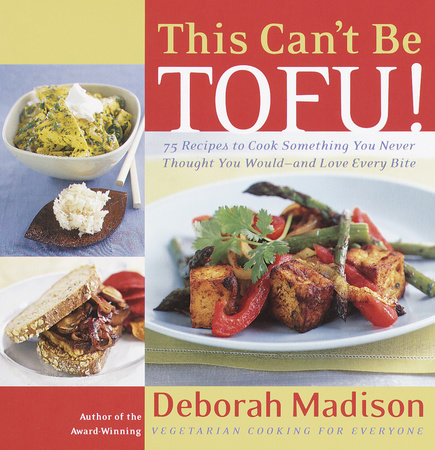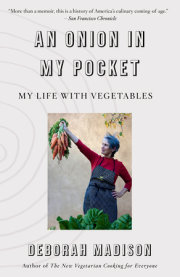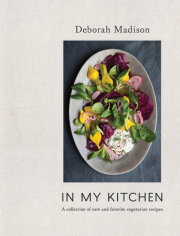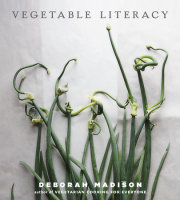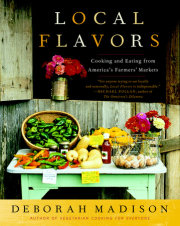Yikes, It's Tofu!IF YOU'VE NEVER ENCOUNTERED TOFU, you may feel perplexed about how to approach it. This is entirely understandable. At first glance, it's simply not like any of the other foods we eat although, with experience, you may find this isn't so. One of the best ways to become acquainted with tofu is to go to a restaurant and order a dish that has tofu, or bean curd, as it's also called. Have a plate of mapo tofu in a Chinese restaurant, or order sukiyaki in a Japanese one, where you'll also find tofu in your miso soup. In a Korean restaurant, you may have a stir-fry of beef and tofu. Many people enjoy tofu in the context of those cuisines where tofu is enough in and of itself and doesn't pretend to be something else. In fact, since working on this book, it seems that everyone I meet is eager to tell me about a wonderful little tofu dish they had in a Thai, Japanese, Korean, or Chinese restaurant.
Similarly, I've found that one of the easiest approaches to cooking tofu at home is to cook it within the traditional flavors you've already encountered in restaurants. The reason why so many of the dishes in this book use ginger, coconut, cilantro, soy sauce, and other Asian ingredients is that they go so well with the delicate, nutty flavor of tofu. It turns out that tofu is also well enhanced by curry spices and Indian cooking techniques. It rather resembles the Indian cheese called paneer, and, in fact, it does stand in well for paneer.
When it comes to translating tofu for a Western palate, there are two main directions you can go in. One is to be quite obvious about it. You know you're eating tofu when you bite into that Bachelor Tofu Sandwich; the surprise is that it's so good. The second is to use tofu so that it disappears. Blend it in a smoothie, whip it into mayonnaise, or add it to a cheese filling for manicotti. I've even had it in a chocolate cake. The surprise is that it's there at all; you would never know.
Another way tofu has been used here, an approach that I'm not at all fond of, is when it masquerades as feta cheese in a salad, a slab of mozzarella in a lasagna, or is crumbled up to imitate hamburger. What a rude surprise when you find out that those white cubes weren't feta cheese after all! These recipes won't lead you to expect one thing, then get another. They're here simply because they taste good.
A lot of people say they don't like tofu, or don't like its texture, but my hunch is that that's a case of tofu being misunderstood. If, after trying these recipes, you find that you still don't like tofu, but want to include it in your diet, then look at the Smoothies and Shakes chapter and enjoy a lot of rich-tasting, creamy drinks.
Disappearing Tofu and DessertWhile most of the recipes in this book treat tofu as a food to be enjoyed for its own intrinsic qualities, tofu can also disappear into dishes so completely that you don't even know it's there. The success of a dessert made with tofu, a tofu mayonnaise, or tofu as feta cheese or sour cream, depends in part on where your food experiences lie. If you like the taste of traditional foods and aren't using tofu in order to avoid eggs or dairy, then including some in a standard recipe gives you the benefits of soy without giving up traditional flavors. For example, you can stir pureed silken tofu into prepared mayonnaise, or into a ricotta filling intended for manicotti, ravioli, or enchiladas, and truly not know the difference. I have a suspicious palate when it comes to substitutes, so you can trust me on this.
When it comes to desserts, you might find soy milk a bit easier to use than tofu. Soy milk can be used wherever milk is called for in a recipe, except where color is important. For example, it makes no difference in a butterscotch tapioca or chocolate pudding, but it might be off-putting in an old-fashioned vanilla custard, simply because its hue can be slightly brownish. Otherwise, soy milk can easily be used as a substitute in dishes such as in cakes and French toast.
In desserts and baked goods, use 2 ounces pureed silken tofu to replace each egg called for in pancake, muffin, quick bread, and cake recipes. Or add tofu along with the eggs, or just the egg whites, to your recipe. The tofu provides moisture and structure to baked goods, yet doesn't interfere with the flavor. It can even be included in a chocolate cake or a pumpkin pie with no one the wiser, and tofu cheesecakes have become rather popular these days. When using pureed tofu in baked goods, make sure that it's completely smooth before adding it to a batter. Any little gobbets of tofu will harden as they bake and leave their visible traces, attractive neither to the tongue nor to the eye.
Not Just for VegetariansTofu is particularly beloved of vegetarians because, among its other qualities, it is an excellent protein source and it is very easy to use in vegetarian dishes. But choosing to eat more tofu doesn't mean that you have to become vegetarian. Traditionally, tofu is often combined with meat in dishes: in sukiyaki, tofu simmers with beef. Across Asia, tofu is seasoned with dried shrimp or oyster sauce, or simmered in chicken stock or daishi no moto, a Japanese stock made with dried bonito. If you are trying to include tofu at your table but are not a vegetarian, add it to stir-fries that you already know how to make, even if they use meat and fish. Reduce the amount of meat you use if that's what you're striving to do.
I have included some recipes that combine tofu with seafood, list both chicken and vegetable stocks as ingredients, and occasionally call for oyster sauce and fish sauce, which are excellent complementary flavorings for tofu. But for the most part, the recipes in this book are made without meat or fowl, since tofu does so well as a substitute for the protein-dense foods and is of special interest to vegetarians or those aiming to eat less meat.
Copyright © 2000 by Deborah Madison. All rights reserved. No part of this excerpt may be reproduced or reprinted without permission in writing from the publisher.





